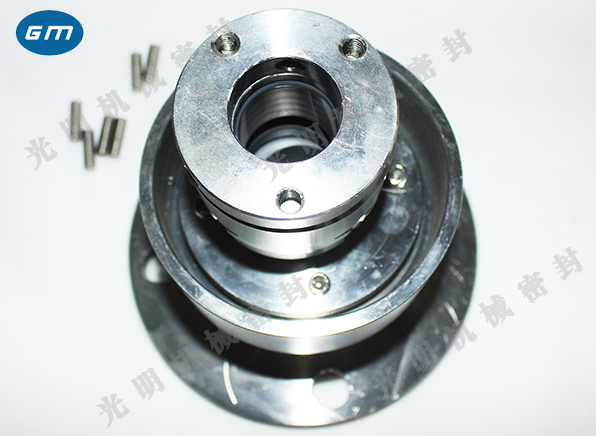1. Preface
Kettle machinery is an important system equipment for industrial production. If leakage occurs in the production and application phase, it will have a negative impact on product quality, and will also emit toxic, explosive and flammable dangerous gases, which will cause significant harm to the ecological environment and the device system itself. If the kettle machinery is overhauled for many times, it is necessary to transfer the materials out and carry out necessary tank washing. This will result in undesirable waste, affect the efficiency of mechanical application, and reduce the yield of products. Moreover, the kettle machinery has a more complex sealing system structure, which requires a high level of maintenance costs and delays the production time. Therefore, it is necessary to effectively extend the service life of mechanical seals and keep them in a good and stable state of application in order to create significant benefits and improve the level of practical production and application.
2、 Mechanical seal for kettle Fault problems
During the mechanical working stage of the reaction kettle, it is necessary to raise the temperature to a temperature range of 160 to 180, and maintain a constant temperature at a certain stage. The pressure in the kettle should be controlled at 1 to 1.5 MPa. Based on frequent temperature rise and fall, the pressure in the kettle and the pressure level in the mechanical seal chamber will be in a long-term change. In the heating stage, with the gradual increase of pressure in the kettle, its meteorological substances will leak into the sealing chamber. When the temperature drops, the sealing liquid in the mechanical seal chamber will penetrate into the kettle, making the lower part of the mechanical seal fail quickly. During the operation phase, it is necessary to turn off the seal cooling water, which will lead to dry friction during the operation phase of dynamic and static rings, and will have a significant impact on the overall service life of mechanical seals.
3. Scientific Strategy for Extending the Application Life of Mechanical Seals for Kettles
3. 1. Extended service life with the help of auxiliary sealing system
In order to ensure that the kettle machinery is always in good and stable operation, the outlet pipeline of the balance tank can be well connected to the mechanical seal chamber with the help of the auxiliary sealing system. In the operation phase, once the gas phase pressure in the kettle gradually increases, its meteorological medium will penetrate into the mechanical seal chamber, making the internal pressure increase. The outlet of the seal chamber, the inlet of the balance tank and the inlet of the industrial air shall be sealed with a prefabricated needle valve, so as to ensure that the pressure difference between the kettle and the mechanical seal chamber is always in a stable state, so as to prevent the meteorological medium in the kettle from continuously penetrating into the mechanical seal chamber, thus causing the lower end face of the seal to be damaged badly, leading to the early formation of poor sealing failure.
3. 2. Effectively introduce balance tank to optimize the application of mechanical seal for kettle
During the operation of kettle machinery, the valve at the outlet of mechanical seal water can be opened, and then the valve at the inlet of seal water can be opened, so that the seal chamber can be well cleaned, thus effectively preventing the problem of magic particle wear caused by dynamic and static rings. Once the water flowing out of the mechanical seal chamber is gradually clear, the inlet valve can be closed and the industrial air inlet valve can be opened, which will continuously reduce the liquid level in the balance tank. Once the falling water level can be observed through the balance tank window, the seal water outlet valve can be closed. After the pressure level of the pressure gauge becomes stable, the industrial air inlet valve can be closed. During the operation phase, one inlet, outlet and industrial air inlet valve of the seal water are kept closed, and the other seal water inlet valve connected to the mechanical seal is kept open. If there is leakage in the balance tank, the open seal water inlet valve can be closed, so that the kettle machinery can continue to operate healthily.
3. 3 Optimize the maintenance and inspection of mechanical integral seal for kettle
The bearing on the mechanical seal element for kettle will continuously increase the bearing clearance after the application service lasts for a period of time, and the size of the inner spacer sleeve should be reduced. In the maintenance and inspection phase, the block gauge shall be used to detect and determine the specific displacement. At the same time, the specific size of the outer spacer sleeve should be regarded as customized, and the specific distance standard of the bearing inner race should be measured. Generally speaking, the measurement should be conducted at three points of 120 degrees, and the average value should be calculated. Then the inner spacer sleeve shall be processed to the measured value to ensure a certain amount of preload. In the maintenance phase of the mechanical balance sleeve for kettle, it is necessary to ensure that it is well grinded to ensure that its roughness meets the standard, so as to optimize the good sealing treatment effect of the balance sleeve and O-ring, and effectively extend the service life of the balance sleeve. The static ring of mechanical seal device and the static ring seat shall be well matched with small clearance to ensure that the static ring can move and turn freely and well. On the contrary, if no good treatment is carried out, the stationary ring will be affected by the spring force and the sealing O-ring will not be compressed evenly. Moreover, it is impossible to ensure that the sealing surfaces of the stationary ring and the dynamic ring have proper perpendicularity with the axis of the main shaft. Under the influence of corrosive gas, the O-ring seal will easily form pits. For this reason, in the maintenance phase, such pits should be treated with high quality, and steel brushes can be used for high quality rust removal and effective cleaning. At the same time, stainless steel welding rod can be used to effectively weld the seal groove, and then the lathe can be used to process the seal groove, so as to ensure that the stationary ring can form a good seal with the same seat. After a certain period of application service, rust and scale will form inside the kettle machinery. In the disassembly phase, the push ring, seat and balance sleeve will be deformed due to knocking. Therefore, in the repair and maintenance phase, filing, deburring, scraping and other methods can be used to make the hole ring in the same seat can slide freely at the balance sleeve, without damaging the balance sleeve, so as to meet the matching accuracy standard.
In short, it is particularly important to optimize the mechanical seal for kettle. In view of the structural characteristics of kettle machinery and the sealing failure problems, we can only improve the service efficiency of kettle machinery application, extend its seal application life, create significant benefits, and achieve high-quality, healthy and sustainable development by adopting scientific and effective countermeasures, introducing auxiliary sealing system, making rational use of balance tank, and doing good maintenance and inspection of the overall seal.












